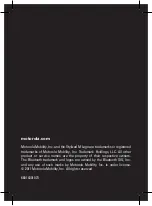
KDFX Reference
KDFX Algorithm Specifications
10-31
Dry Bal
The left-right balance of the dry signal. A setting of -100% allows only the left dry signal to
pass to the left output, while a setting of 100% lets only the right dry signal pass to the
right output. At 0%, equal amounts of the left and right dry signals pass to their respective
outputs.
Hold
A switch which when turned on, locks any signal currently in the delay to play until Hold
is turned off. When Hold is on, no signal can enter the delay and Feedback is set to 100%
behind the scenes. Hold does not affect the HF Damping or Wet/Dry mix.
Loop Crs
The coarse delay length of the Loop tap. If the feedback is turned up, this parameter sets
the repeating delay loop length. The resolution of the coarse adjust is 20 milliseconds, but
fi
ner resolution can be obtained using the Loop Fine parameter. The maximum delay
length is 2.55 seconds (2550ms) for the 4-Tap Delay.
Loop Fine
A
fi
ne adjustment to the Loop tap delay length. The delay resolution is 0.2 milliseconds
(ms). Loop Fine is added to Loop Crs (coarse) to get the actual delay length.
Tapn Crs
The coarse delay lengths of the output taps (n = 1...4). The resolution of the coarse adjust
is 20 milliseconds, but
fi
ner resolution can be obtained using the Tapn Fine parameters.
The maximum delay length is 2.55 seconds (2550ms) for the 4-Tap Delay.
Tap
n
Fine
A
fi
ne adjustment to the output tap delay lengths (n = 1...4). The delay resolution is 0.2
milliseconds (ms). Tapn Fine is added to Tapn Crs (coarse) to get actual delay lengths.
Tap
n
Level
The amount of signal from each of the taps (n = 1...4) which get sent to the output. With
the Loop Lvl control, you can give different amounts of emphasis to various taps in the
loop.
Tap
n
Bal
The left-right balance of each of the stereo taps (n = 1...4). A setting of -100% allows only
the left tap to pass to the left output, while a setting of 100% lets only the right tap pass to
the right output. At 0%, equal amounts of the left and right taps pass to their respective
outputs.
Algorithm 132 4-Tap Delay BPM
In this Algorithm, the delay length for any given tap is determined by the tempo, expressed in beats per
minute (BPM), and the delay length of the tap expressed in beats (bts). The tempo alters all tap lengths
together. With the tempo in beats per minute and delay lengths in beats, you can calculate the length of a
delay in seconds as beats/tempo * 60 (sec/min). IMPORTANT NOTE: KDFX has a limited amount of
delay memory available (over 2.5 seconds for 4-Tap BPM). When slow tempos and/or long lengths are
speci
fi
ed, you may run out of delay memory, at which point the delay length will be cut in half. When you
slow down the tempo, you may
fi
nd the delays suddently getting shorter.
A repetitive loop delay is created by turning up the feedback parameter (Fdbk Level). Only the Loop tap is
fed back to the input of the delay, so this is the tap which controls the loop rate. Usually you will want the
Loop tap (LoopLength parameter) to be longer than the other tap lengths. To repeat a pattern on a 4/4
measure (4 beats per measure) simply set LoopLength to 4 bts. The output taps can then be used to
fi
ll in
the measure with interesting rhythmical patterns. Setting tap levels allows some “beats” to receive
different emphasis than others.
Summary of Contents for K2661
Page 18: ...2 4 LFOs LFO Shapes...
Page 34: ...3 16 DSP Algorithms...
Page 54: ...5 4 MIDI Note Numbers Note Numbers for Percussion Keymaps...
Page 72: ...7 10 System Exclusive Protocol K2661 System Exclusive Implementation...
Page 82: ...9 4 Upgrading Sample Memory Choosing and Installing a SIMM for K2661 Sample Memory...
Page 334: ...10 252 KDFX Reference KDFX Algorithm Specifications...
Page 340: ...11 6 Glossary...
Page 382: ...12 42 Triple Modular Processing Alphanumeric Buttonpad Entries for DSP Functions...
Page 392: ...B 6 SysEx Control of KDFX MSB and LSB...
Page 442: ...D 20 Contemporary ROM Block Objects Controller Assignments Contemporary ROM Block...
Page 490: ...H 12 General MIDI Standard Mode Controller Assignments...
Page 492: ...I 2 Live Mode Objects Live Mode Programs...
Page 498: ...K2661 Musician s Reference Index...
Page 500: ......
















































